Teff
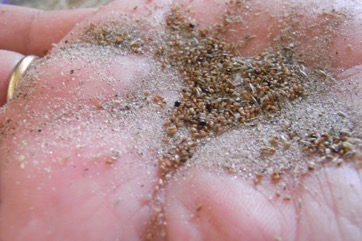
A tropical plant. A drought resistant grass. It grows in places with a distinct dry season. It grows best at about 2000 m altitude in Ethiopia. The temperatures are about 25-28°C. It is grown from 1700 m to 2800 m. Brown teff is grown at the higher locations. The rainfall in this region is about 950-1000 mm. It can be grown with rainfall of 400 mm. Soils should be permeable. It can tolerate frost. It can grow in arid places. In Argentina it grows between 1,200-1,300 m above sea level.
Also known as:
Bousa, Ersho, Ethiopian lovegrass, Injara, Injera
Synonyms
- Eragrostis abyssinica (Jacq.) Link
- Poa abyssinica Jacq.
- Poa tef Zuccagni
Edible Portion
- Seeds, Cereal
Where does Teff grow?
Found in: Africa, Argentina, Asia, Australia, Botswana, Brazil, Britain, Canada, Central Africa, Congo, East Africa, Egypt, Eritrea, Ethiopia, Fiji, France, Germany, Ghana, Guyana, India, Indochina, Japan, Kenya, Lesotho, Madagascar, Malawi, Mozambique, Myanmar, Namibia, New Caledonia, North Africa, North America, Pacific, Saudi Arabia, SE Asia, Somalia, South Africa, Southern Africa, South America, Sudan, Tanzania, Thailand, Uganda, United States, Yemen, Zambia, Zimbabwe
Notes: The seeds have high food value. There are about 300 Eragrostis species. It is gluten free. It is a C4 plant. It contains no gluten.
Status: A staple food in some parts of Ethiopia. It is mostly eaten by the wealthier people. It is a cultivated food plant. It is grown on 2.5 million ha.
Growing Teff
Cultivation: Teff is best grown in fallowed land or after legume crops. Land preparation needs to be very thorough. A fine firm weed free seed bed is needed. Seed are mostly broadcast. Driving sheep or cattle over the land is used to trample in the seed. 25-30 kg of seed per hectare are recommended. Nitrogen fertiliser is recommended. It is usually harvested with sickles.
Edible Uses: Seeds are ground into flour and cooked in a variety of ways. It can be used in stews. They are used to make unleavened bread. This is called injera in Ethiopia.
Production: It is fast growing. Plants take between 90-120 days for early varieties and 120-160 days for late maturing varieties. Yields range between 300 and 3000 kg per hectare. Seeds can be stored for many years as a reserve food supply.
Nutrition Info
per 100g edible portion| Edible Part | Energy (kcal) | Protein (g) | Iron (mg) | Vitamin A (ug) | Vitamin c (mg) | Zinc (mg) | % Water |
|---|---|---|---|---|---|---|---|
| Seeds | 368 | 8.9 | 9.9 | - | - | 20 | 9.3 |
Teff Photos

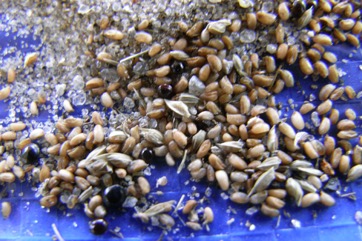
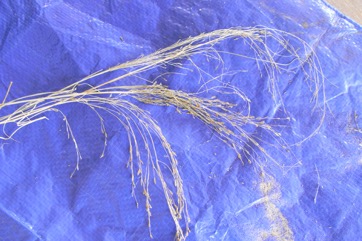
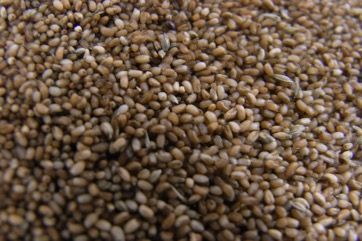
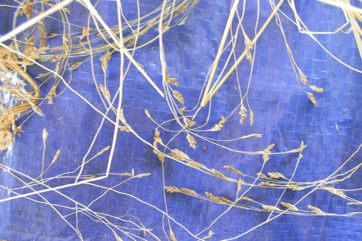
References
Ambasta, S.P. (Ed.), 2000, The Useful Plants of India. CSIR India. p 198
Boll. Soc. Bot. Ital. 1918:62. 1918
Facciola, S., 1998, Cornucopia 2: a Source Book of Edible Plants. Kampong Publications, p 175
FAO, 1988, Traditional Food Plants, FAO Food and Nutrition Paper 42. FAO Rome p 264
Hedrick, U.P., 1919, (Ed.), Sturtevant's edible plants of the world. p 508 (As Poa abyssinica)
Heywood, V.H., Brummitt, R.K., Culham, A., and Seberg, O., 2007, Flowering Plant Families of the World. Royal Botanical Gardens, Kew. p 394
Jardin, C., 1970, List of Foods Used In Africa, FAO Nutrition Information Document Series No 2.p 3
Kiple, K.F. & Ornelas, K.C., (eds), 2000, The Cambridge World History of Food. CUP p 116, 1868
Lazarides, M. & Hince, B., 1993, Handbook of Economic Plants of Australia, CSIRO. p 92
Maundu, P. et al, 1999, Traditional Food Plants of Kenya. National Museum of Kenya. 288p
Molla, A., Ethiopian Plant Names. http://www.ethiopic.com/aplants.htm (As Eragrostis abyssinica)
Nyadanu, D., et al, 2015, Agro-biodiversity and challenges of on-farm conservation: the case of plant genetic resources of neglected and underutilized crop species in Ghana. Genet. Resourc. Crop Evol. 62(7):
Peters, C. R., O'Brien, E. M., and Drummond, R.B., 1992, Edible Wild plants of Sub-saharan Africa. Kew. p 22
Plants for a Future database, The Field, Penpol, Lostwithiel, Cornwall, PL22 0NG, UK. http://www.scs.leeds.ac.uk/pfaf/
PROSEA (Plant Resources of South East Asia) handbook Volume 10 Cereals. p 150
Purseglove, J.W., 1972, Tropical Crops. Monocotyledons. Longmans p 157
Royal Botanic Gardens, Kew (1999). Survey of Economic Plants for Arid and Semi-Arid Lands (SEPASAL) database. Published on the Internet; http://www.rbgkew.org.uk/ceb/sepasal/internet [Accessed 3rd June 2011]
Reis, S. V. and Lipp, F. L., 1982, New Plant Sources for Drugs and Foods from the New York Botanical Garden herbarium. Harvard. p 11
Ruiters-Welcome, A. K., 2019, Food plants of southern Africa. Ph.D. thesis. Univ. of Johannesburg p 87
Seyfu Ketema. 1997. Tef. Eragrostis tef (Zucc.) Trotter. Promoting the conservation and use of underutilized and neglected crops. 12. Institute of Plant Genetics and Crop Plant Research, Gatersleben/International Plant Genetic Resources Institute, Rome, Italy
Smith, P.M., 1979, Tef, in Simmonds, N.W., (ed), Crop Plant Evolution. Longmans. London. p 308
Tefera, H. & Belay, G., 2006. Eragrostis tef (Zuccagni) Trotter. [Internet] Record from Protabase. Brink, M. & Belay, G. (Editors). PROTA (Plant Resources of Tropical Africa), Wageningen, Netherlands. < http://database.prota.org/search.htm>. Accessed 16 October 2009.
USDA, ARS, National Genetic Resources Program. Germplasm Resources Information Network - (GRIN). [Online Database] National Germplasm Resources Laboratory, Beltsville, Maryland. Available: www.ars-grin.gov/cgi-bin/npgs/html/econ.pl (10 April 2000)
van Wyk, B., 2005, Food Plants of the World. An illustrated guide. Timber press. p 189
Vaughan, J. C. & Geissler, C. A., 2009, The new Oxford Book of Food Plants. Oxford University Press. p 4
Vickery, M.L. and Vickery, B., 1979, Plant Products of Tropical Africa, Macmillan. p 13
World Checklist of Useful Plant Species 2020. Royal Botanic Gardens, Kew